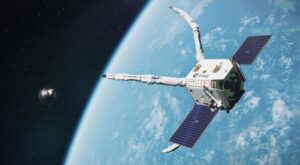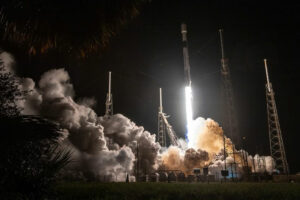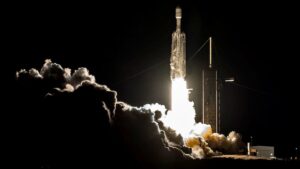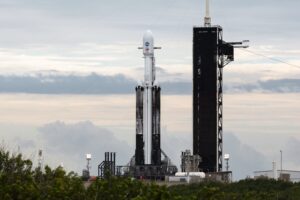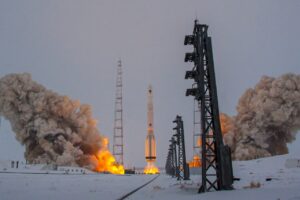
Japan is set to launch a replacement satellite Monday for a navigation spacecraft that has been in space since 2010, augmenting the U.S. military’s GPS network to provide more precise positioning and timing services over the Asia-Pacific region.
The new satellite will join Japan’s Quasi-Zenith Satellite System, or QZSS, which helps give users better estimates of their position, especially in cities and remote regions, where skyscrapers, trees and mountains can block signals from GPS satellites.
A Japanese H-2A rocket is set to deploy the new satellite, named QZS 1R or Michibiki 1R, to replace the first Michibiki spacecraft launched on a previous H-2A flight in September 2010. The QZS 1 satellite is beyond its original 10-year design life.
Liftoff of the 174-foot-tall (53-meter) H-2A rocket from Tanegashima Space Center in southwestern Japan is scheduled for a 15-minute window opening at 10:19:37 p.m. EDT Monday (0219 GMT; 11:19 a.m. Japan Standard Time on Tuesday).
Let je bil prestavljen za 24 ur zaradi slabe vremenske napovedi za prvo izstrelitev misije.
Japanese teams from Mitsubishi Heavy Industries, the H-2A’s prime contractor and operator, rolled the rocket from its assembly building to the launch pad around 15 hours before liftoff. The 1,600-foot (500-meter) journey on a mobile launch table took about 30 minutes to complete.
Once at the launch pad, the rocket was connected to ground electrical and propellant systems, allowing the H-2A team to start loading liquid hydrogen and liquid oxygen into the launcher’s first and second stage tanks.
QZS 1R, built by Mitsubishi Electric Corp., weighs about 4 metric tons (4.4 tons) fully fueled on top of the H-2A rocket.
The H-2A rocket is fitted with two strap-on solid rocket boosters, providing the majority of the 1.4 million pounds of thrust to push the launcher off the pad.
A cryogenic hydrogen-fueled LE-7A main engine powers the core stage, and another cryogenic engine — the LE-5B — is mounted to the rocket’s second stage.
Heading east after liftoff from Tanegashima, the rocket’s strap-on boosters will consume their propellant in about two minutes before jettisoning to fall into the Pacific Ocean. The core stage, covered in a blanket of orange insulating foam, will burn for about six-and-a-half minutes.
Then the upper stage’s LE-5B engine will ignite for two maneuvers to inject the QZS 1R satellite into an elliptical transfer orbit stretching more than 22,000 miles (about 36,000 kilometers) above Earth. Deployment of the spacecraft is scheduled about 28 minutes after liftoff.

Designed for a 15-year lifetime, the spacecraft will use its own propulsion system to reach a near-circular geosynchronous orbit with an average altitude of about 22,000 miles. The QZS 1R satellite will settle into an operational orbit tilted between 40 and 45 degrees to the equator, where it will circle the planet once every 24 hours.
Flota štirih satelitov QZSS, popolnoma združljiva z omrežjem GPS, je nameščena v orbitah, ki lebdijo nad Japonsko. Sateliti GPS, ki jih upravljajo vesoljske sile ZDA, krožijo okoli Zemlje v nižjih orbitah, kar pomeni, da so različna vesoljska plovila vidna na nebu ob različnih časih.
Projicirana proti površini Zemlje bo talna sled satelita QZS 1R zarisala asimetričen vzorec osmice, ki se razteza od Japonske do Avstralije, ko se izmenjuje severno in južno od ekvatorja. Trije od aktivnih kvazizenitnih satelitov so nameščeni v podobnih nagnjenih geosinhronih orbitah, še en pa je parkiran v geostacionarni orbiti nad ekvatorjem in ostaja v fiksnem položaju nad planetom.
Tako kot satelit, ki ga nadomešča, bo tudi QZS 1R približno osem ur vsak dan blizu zenita ali skoraj naravnost navzgor na japonskem nebu. S popolnim naborom satelitov konstelacija omogoča neprekinjeno pokrivanje Japonske.
Michibiki v japonščini pomeni "vodenje" ali "kazovanje poti".
Za izračun natančnega položaja na Zemlji so potrebni štirje sateliti GPS, vendar bo satelit Michibiki, ki oddaja iste signale L-pasu, dal sprejemniku oceno, če ni vidnih dovolj satelitov GPS, ali pa lahko celo pomaga pri natančnejšem izračunu položaja s popolno storitvijo GPS.
Japonska razvija še tri kvazi-zenit navigacijske satelite za izstrelitev do konca leta 2023. Razširjena flota sedmih vesoljskih plovil bo Japonski zagotovila popolno navigacijsko pokritost nad japonskim ozemljem, neodvisno od kakršnih koli signalov GPS.
E-pošta Avtor.
Sledite Stephenu Clarku na Twitterju: @ StephenClark1.
Source: https://spaceflightnow.com/2021/10/25/japanese-h-2a-rocket-ready-for-launch-with-navigation-satellite/- "
- 000
- 11
- aktivna
- Dovoli
- okoli
- Avstralija
- Building
- Krog
- Mesta
- porabijo
- Izvajalec
- telo
- kredit
- kriogeni
- dan
- Oblikovanje
- električni
- ocene
- prva
- FLET
- let
- polno
- gps
- HTTPS
- vodik
- industrij
- IT
- Japonska
- pridružite
- kosilo
- Tekočina
- Večina
- milijonov
- Mobilni
- Ponedeljek
- ostalo
- mreža
- sever
- ocean
- Priložnost
- Kisik
- Pacific
- Vzorec
- planet
- slaba
- funtov
- zvitki
- satelit
- satelitov
- Storitve
- nastavite
- Delite s prijatelji, znanci, družino in partnerji :-)
- South
- Vesolje
- Space Force
- vesoljska plovila
- Stage
- Začetek
- Površina
- sistem
- sistemi
- Testiranje
- čas
- Tone
- vrh
- sledenje
- tweet
- nas
- Uporabniki
- tehta


